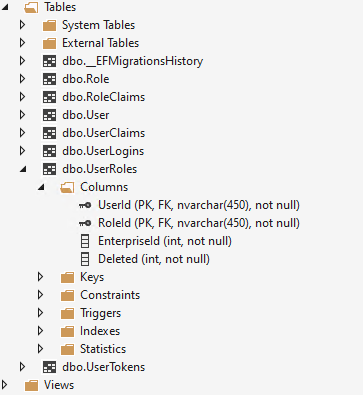Hi @Mohammad Arar (MiddleEast) ,
When Extend IdentityUserRole and add migration it create the AspNetUserRole table again
I could reproduce the problem, the issue relates the DbContext, after modifying the ApplicationDbContext as below:
public class ApplicationDbContext : IdentityDbContext<ApplicationUser, IdentityRole, string, IdentityUserClaim<string>, ApplicationUserRole, IdentityUserLogin<string>, IdentityRoleClaim<string>, IdentityUserToken<string>>
{
The whole ApplicationDbContext:
public class ApplicationDbContext : IdentityDbContext<ApplicationUser, IdentityRole, string, IdentityUserClaim<string>, ApplicationUserRole, IdentityUserLogin<string>, IdentityRoleClaim<string>, IdentityUserToken<string>>
{
public ApplicationDbContext(DbContextOptions<ApplicationDbContext> options)
: base(options)
{
}
protected override void OnModelCreating(ModelBuilder builder)
{
builder.ApplyConfigurationsFromAssembly(Assembly.GetExecutingAssembly());
base.OnModelCreating(builder);
builder.Entity<ApplicationUser>(entity =>
{
entity.ToTable(name: "User");
});
builder.Entity<IdentityRole>(entity =>
{
entity.ToTable(name: "Role");
});
builder.Entity<ApplicationUserRole>(entity =>
{
entity.ToTable(name: "UserRoles"); ;
});
builder.Entity<IdentityUserClaim<string>>(entity =>
{
entity.ToTable("UserClaims");
});
builder.Entity<IdentityUserLogin<string>>(entity =>
{
entity.ToTable("UserLogins");
//in case you chagned the TKey type
// entity.HasKey(key => new { key.ProviderKey, key.LoginProvider });
});
builder.Entity<IdentityRoleClaim<string>>(entity =>
{
entity.ToTable("RoleClaims");
});
builder.Entity<IdentityUserToken<string>>(entity =>
{
entity.ToTable("UserTokens");
//in case you chagned the TKey type
// entity.HasKey(key => new { key.UserId, key.LoginProvider, key.Name });
});
}
}
You can check the generate migration file from here: 273544-sourcecode.txt
And the database table as below:

If the answer is the right solution, please click "Accept Answer" and kindly upvote it. If you have extra questions about this answer, please click "Comment".
Note: Please follow the steps in our documentation to enable e-mail notifications if you want to receive the related email notification for this thread.
Best regards,
Dillion